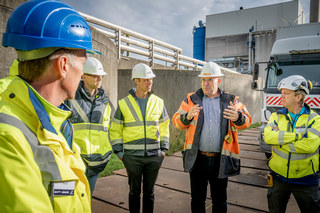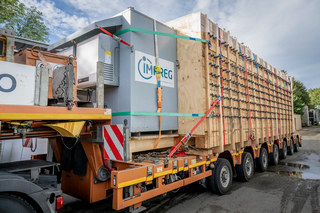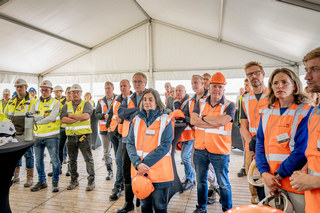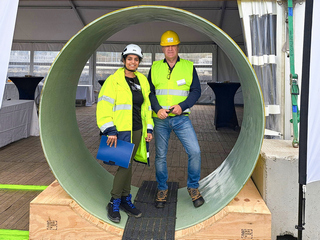Two-Meter CIPP Giant, Zero Downtime: UV-Cured GRP Relines Main Collector in Belgium
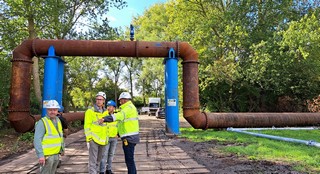
Bypass of 13,000 m³/h: Pumping stations and pressure sewer pipes to divert the flow from the rehabilitation stretch to ensure continues flow towards WWTP
Belgian sewer operator Aquafin and their contractor TM Kumpen – Willemen Infra hosted a site visit for project partners and international guests at the wastewater treatment plant RWZI in Bruges, Belgium. They witness first-hand the renovation of the major sewer collectors serving 238,500 residents. Massive collectors (diameters 1500–2000 mm) that transport wastewater from the city and surrounding area are being structurally renewed.
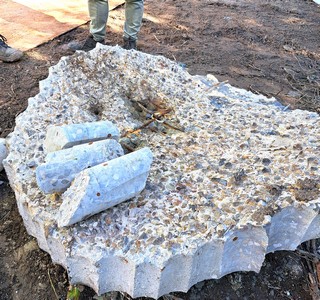
Extracted piece of host reinforced concrete pipe shows corrosion with coarse aggregates and dissolved reinforcement bars.
Why Renovation Was Urgent
Inspection revealed that the reinforced concrete host pipes, originally 19 cm thick, had in some places been reduced to as little as 2 cm due to severe corrosion caused by hydrogen sulfide (H₂S). In certain sections, reinforcement steel had already dissolved. Without intervention, the risk of sewer collapse and subsequent sinkholes would have been high, with major social, ecological, and economic consequences.
To guarantee continued wastewater transport during the works, a temporary bypass pumping system was installed, capable of diverting up to 13,000 m³/hour to the treatment plant. This ensured uninterrupted operations while rehabilitation proceeded in 60-hour continuous shifts.
A Project of Exceptional Complexity
Christa Coppens, Project Manager at Aquafin, highlighted the unique challenges:
- Long and large-diameter (1500–2000 mm) pressure pipelines at depths up to 9 meters
- Highly permeable and potentially contaminated soil
- Strong H₂S formation and severe pipe deterioration
- Need for sustainable execution with minimal disruption
- Requirement to maintain continuous wastewater treatment plant discharge
Optimized CIPP Solution
Given the complexity, Aquafin opted for a competitive procedure with negotiation rather than a traditional open tender. This approach enabled contractors to propose optimized solutions within defined boundaries, fostering collaboration, trust, and innovation.
Relining with Quality and Safety at the Forefront
According to Gert-Jan Merkx, General Manager at Kumpen, success depended on combining technical expertise with strict safety management. Deep excavations, manhole rehabilitations, and access shafts were managed under stringent safety rules, with all site visitors wearing helmets, safety shoes, and high-visibility vests during the tour.
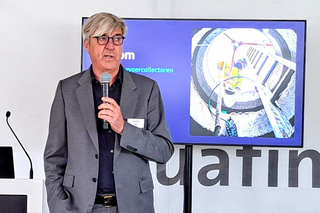
Danny Baeten, director of project management at Aquafin, delivering the welcome note to around 30 delegates from Europe
Preventive Management Pays Off
Danny Baeten, Director of Project Management at Aquafin, emphasized the wider context:
“Every €1 invested in preventive management saves €3–5 in emergency repairs and damage. By renovating today, we safeguard public funds, protect past investments, and avoid costly surprises tomorrow.”
The Flemish sewer network, valued at over €10 billion, faces increasing pressure from aging infrastructure. Proactive projects such as Bruges demonstrate the importance of timely rehabilitation to avoid ecological damage, sinkholes, and untreated discharges into nature.
An International Exchange of Knowledge
The site visit at RWZI Brugge welcomed over 30 delegates, including participants from the Netherlands (Arnhem), Germany, and Belgium. The group toured the site in teams of six, observing preparations such as the installed preliner, protective foils, and manhole laminations. Installation of the impregnated GRP liner began the following day, with continuous work planned for 60 hours.
During the visit, Danny Verhulst from Aquafin kindly hosted the tour in English, for Ashwini Ausekar. We had engaging discussions on innovation in sewer rehabilitation, particularly regarding corrosion and acid attack in concrete pipes – an issue of growing relevance across world. His openness in sharing expertise and perspectives made the exchange especially valuable.Ashwini Ausekar was very impressed: “This project is a milestone for trenchless rehabilitation in Europe. The combination of scale, innovative UV-cured GRP technology, and the collaborative procurement model sets a new benchmark for complex underground infrastructure works. I am grateful to Aquafin and TM Kumpen – Willemen Infra for the kind invitation and warm hospitality, and especially to Danny Baeten and Danny Verhulst for making the visit both insightful and inspiring.”
Contact Person
Ashwini Ausekar, M.Sc.
phone: +49 209 17806-0
email: ausekar@ikt.institute
